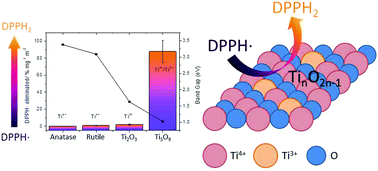当前位置:
X-MOL 学术
›
Chem. Commun.
›
论文详情
Our official English website, www.x-mol.net, welcomes your
feedback! (Note: you will need to create a separate account there.)
Scavenging activity of Magnéli phases as a function of Ti4+/Ti3+ ratios
Chemical Communications ( IF 4.3 ) Pub Date : 2017-08-29 00:00:00 , DOI: 10.1039/c7cc05862d M. Canillas 1, 2, 3, 4 , E. Chinarro 1, 2, 3, 4 , A. P. Pêgo 5, 6, 7, 8, 9 , B. Moreno 1, 2, 3, 4
Chemical Communications ( IF 4.3 ) Pub Date : 2017-08-29 00:00:00 , DOI: 10.1039/c7cc05862d M. Canillas 1, 2, 3, 4 , E. Chinarro 1, 2, 3, 4 , A. P. Pêgo 5, 6, 7, 8, 9 , B. Moreno 1, 2, 3, 4
Affiliation

|
TiO2 is able to scavenge reactive oxygen and nitrogen species (ROS and RNS) in the absence of light. The scavenging mechanism has been related to the chemistry of defects (oxygen vacancy reduced oxidation states of Ti) but it is still unknown. This study describes the ROS scavenging activity of different titanium oxide phases and relates their scavenging activities with the Ti4+/Ti3+ molar ratio as well as the band gap value. The Ti5O9 phase, with a mixture of both oxidation states, presented a substantially higher percentage of 2,2-diphenyl-1-picrylhydracyl radicals (DPPH˙) eliminated per m2 of specific surface area in comparison to phases with predominant oxidation states Ti4+ or Ti3+ such as TiO2 and Ti2O3, respectively. The obtained results indicate that the DPPH˙ scavenging mechanism corresponds to a catalytic process on the Ti5O9 surface which is facilitated by the presence of charges that can easily move through the material. The mobility of charges and electrons in the semiconductor surface, related to the presence of oxidation states Ti4+ and Ti3+ and a small band gap, could create an attractive surface for radical species such as DPPH˙. This puts forward Ti5O9 as a promising candidate coating for implantable biomedical devices, as an electrode, since it can cushion inflammatory processes which could lead to device encapsulation and, consequently, failure.
中文翻译:

Magnéli相的清除活性随Ti 4+ / Ti 3+比例的变化
TiO 2可以在无光的情况下清除活性氧和氮(ROS和RNS)。清除机理与缺陷的化学性质(氧空位降低了Ti的氧化态)有关,但仍是未知的。本研究描述了不同钛氧化物相的ROS清除活性,并将其清除活性与Ti 4+ / Ti 3+摩尔比以及带隙值相关。与具有主要氧化相的相相比,具有两种氧化状态的混合物的Ti 5 O 9相具有每m 2比表面积所消除的2,2-二苯基-1-甲基羟酰基(DPPH˙)的百分比要高得多州Ti4+或Ti 3+,例如TiO 2和Ti 2 O 3。所获得的结果表明,DPPH 3清除机理对应于在Ti 5 O 9表面上的催化过程,这是由于存在易于移动通过材料的电荷而促进的。半导体表面中电荷和电子的迁移率与氧化态Ti 4+和Ti 3+的存在以及较小的带隙有关,可以为自由基物质(例如DPPH 3)形成吸引人的表面。这提出了Ti 5 O 9 作为可植入生物医学设备的有希望的候选涂层,作为电极,因为它可以缓和炎症过程,而炎症过程可能导致设备封装并因此而失效。
更新日期:2017-09-21
中文翻译:

Magnéli相的清除活性随Ti 4+ / Ti 3+比例的变化
TiO 2可以在无光的情况下清除活性氧和氮(ROS和RNS)。清除机理与缺陷的化学性质(氧空位降低了Ti的氧化态)有关,但仍是未知的。本研究描述了不同钛氧化物相的ROS清除活性,并将其清除活性与Ti 4+ / Ti 3+摩尔比以及带隙值相关。与具有主要氧化相的相相比,具有两种氧化状态的混合物的Ti 5 O 9相具有每m 2比表面积所消除的2,2-二苯基-1-甲基羟酰基(DPPH˙)的百分比要高得多州Ti4+或Ti 3+,例如TiO 2和Ti 2 O 3。所获得的结果表明,DPPH 3清除机理对应于在Ti 5 O 9表面上的催化过程,这是由于存在易于移动通过材料的电荷而促进的。半导体表面中电荷和电子的迁移率与氧化态Ti 4+和Ti 3+的存在以及较小的带隙有关,可以为自由基物质(例如DPPH 3)形成吸引人的表面。这提出了Ti 5 O 9 作为可植入生物医学设备的有希望的候选涂层,作为电极,因为它可以缓和炎症过程,而炎症过程可能导致设备封装并因此而失效。











































 京公网安备 11010802027423号
京公网安备 11010802027423号